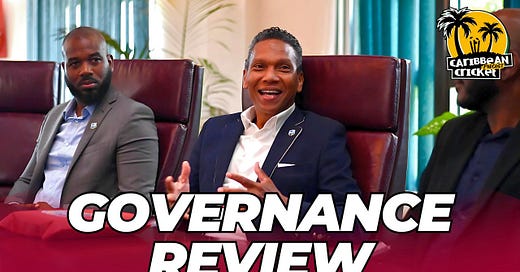During my studies in Germany, I had a flatmate who was interning at the local football club, Hamburg Sport Verein (HSV).
Naturally, sports was how we decided to bond with one another. One night, while he played FIFA on his PS4, he expressed frustrations with sporting culture and said, “keep politics and sports separate”. I didn’t say anything in the moment, but naturally, I disagreed with him.
Modern sport is inherently political, especially in the case of West Indies cricket and its global impact. Sports is politics on a turf.
Cricket West Indies, a singular team that represents an entire region of diverse cultures and peoples across two continents, has been a medium of unity for over a century. It has withstood the rise and fall of federations and organisations that sought to do exactly what the sports team was already doing by accident - bring together the region into a collective voice- to consolidate power on the global stage so that the people within the region can never go overlooked again.
Some may argue that Cricket West Indies no longer holds the same technocratic power and unity as before. However, the West Indies brand still carries enough significance to remain relevant in this discussion.
While cricket naturally unified the Caribbean, political institutions struggled to do the same. The West Indies Federation ultimately failed, but from its ashes, CARICOM emerged in 1973 as the region’s economic and political union.
It is contentious if CARICOM, especially in modernity, does enough to foster a cohesive identity, not only between the individual nations under her jurisdiction, but also between the individual peoples therein.
Ask yourself the question right now– do you feel closer to the region because of CARICOM? Or because of cricket? I know my answer.
I attended a T20 World Cup match where the West Indies played New Zealand and I sat next to Jamaicans, Barbadians, Trinidadians, Americans, and Guyanese. Despite not knowing any of them before that match, during the game, they were my siblings. We shared food and cheers and when Nicholas Pooran’s wicket fell, we threw curses at the pitch together. When the entire stadium sang Rally Round the West Indies with David Rudder, I felt a oneness I had literally never felt before.
For most people, it doesn't matter that Clive Lloyd was from Guyana; he led the West Indies during our 20 year domination, and in so doing, represented all of us, just as Sir Viv Richards and Sir Ambrose, Lara, Gayle, and Sarwan did. When those players wore their badges, they stopped representing their island solely, and became emblems for every person on West Indian soil. It is in this context that the question is begged, “Has West Indies Cricket united the region more than CARICOM?”.
Cricket As a Political Weapon:
"Cricket had plunged me into politics long before I was aware of it. When I did turn to politics, I did not have too much to learn." C.L.R. James, Beyond a Boundary.
Let’s get the obvious out of the way- whilst CARICOM has been used as a governing tool, cricket in the West Indies needed to stand against and upend the roots of colonialism.
As Dr. Claudius Fergus phrased it, cricket in the 1950s, “was the domain of white elites before the African working class.”, where figures like C.L.R. James sought to dismantle the “British West Indies” iconography by forcing the installation of the first black captain. See the full address by Dr Claudius Fergus, Deryck Murray and Philo Wallace here
From that moment onwards, from the second Frank Worrell became Cricket West Indies’ first black captain, every run scored and wicket taken was an affront to the colonial powers. Every run was a march for freedom. The very existence of the team was a declaration:
‘We, the sons and grandsons of your former slaves, are not lesser than you. We may not even be equal. We are stronger, smarter, and more powerful than you ever realised, and we will confront you.’
That message transcended all of the differences in religion, colour, gender, etc. in the region. It was our rallying cry. Cricket stopped being a game and even the team’s national anthem embodied that spirit with the opening line;
“No noble thoughts brought us here to this region, but through it all we have risen above,” David Rudder.
These rebellious roots only dug deeper upon winning the first ever Cricket World Cup against England at Lord’s. To everyone in the Caribbean, it was like beating your landlord at Monopoly and then refusing to pay rent.
Dominic Malcolm expands on this idea in far more detail than I can here in his book, “ Globalizing Cricket: Codification, Colonization and Contemporary Identities.”
While cricket was a tool of defiance against colonial rule on the global stage, its impact did not stop there. Beyond politics, cricket seeped into the everyday lives of Caribbean people at the individual level, shaping personal identities, cultural expressions, our infrastructure, and even childhood memories.
Cricket at the Individual Level
Even outside the international spotlight, cricket has quietly stitched the Caribbean together. From schoolyards to local tournaments, the sport forges cross-border relationships early. Young cricketers train and compete across islands, blending national identities into a shared West Indian experience. You don’t just play for your home island; you play for the region.
Take the Caribbean Premier League (CPL)—an economic venture, sure, but also an incubator for regional solidarity. Trinidadians cheered for the Barbados Tridents in 2016 because half the squad was Trini. Nicholas Pooran, a Trinidadian, found a second home under the Guyanese and Barbadian flags. These weren’t just contracts; they were cultural exchanges, reinforcing a deeper bond that politics often fails to nurture.
Off the field, cricket seeps into everyday life. I studied "Test Match Sabina Park" by Stewart Brown in school, read Michael Anthony’s "Cricket in the Road", and just last week, I spotted a children’s book titled "I Am a Cricketer" in my local bookstore. I remember the old man on my street who threatened us with an old cricket bat for stealing his mangoes. I pass by Brian Lara’s statue every week, a permanent fixture in Trinidadian life. Whether we realize it or not, cricket is a living history book—an unwritten curriculum of Caribbean identity.
You don’t have to like the sport to feel its presence. Meanwhile, CARICOM—a body explicitly created to unify the region—has yet to achieve the same cultural entrenchment. Where cricket naturally fosters unity, CARICOM remains an abstract institution, struggling to make its presence truly felt.
The Failures of CARICOM as a Uniter:
In contrast, CARICOM lacks the flamboyant and rebellious history of CWI. Yes, it was born from the idea of unity, however, since its formation, the organisation has not been able to achieve similar feats and moments where the nations felt truly represented on the global stage.
Part of this is due to CARICOM having never seriously faced an external threat the same way Cricket West Indies faced England. England was the region’s catalyst for unity- a villain bigger than any nation alone. CARICOM, on the other hand, has only faced internal challenges. Its impact has been limited by political divisions, economic disparities, and slow decision-making processes. Issues such as trade agreements, immigration policies, and currency integration breed disagreements, weakening the vision of a united Caribbean.
Insularity and bureaucracy; a poison that affects Cricket West Indies, however, it appears that it is much more deep rooted into CARICOM as member states prioritize national sovereignty over regional unity.
Unlike the European Union, it has failed to establish shared governance that benefits all. This political fragmentation fuels bureaucratic inefficiencies—agreements take years to ratify, often delayed by political maneuvering, competing interests, and outright obstruction from nations unwilling to compromise - or as we say in the Caribbean, Politricking.
This sluggishness reduces CARICOM’s effectiveness especially in responding to time-sensitive regional challenges, making it almost impossible to effectively represent and amplify the voices of the people of the region.
Economics; just as the region is diverse in its culture, religion, ethnic background, etc, so too are the member states vastly different from one another on the economic platform. Nations like Trinidad and Tobago and, recently, Guyana maintain their economies primarily through resource management and exportation, with things like Carnival, nature, and food only subsidising the primary economic diuretic.
Naturally, policies that are beneficial to them would hardly be as beneficial to service-based economies like Barbados or tourism-centered economies like Antigua and Barbuda. This inability to settle upon economic policies that are equally beneficial to all members lock CARICOM in a permanent state of inaction. Additionally, intra-regional trade remains weak due to tariffs, inconsistent regulations, and protectionist policies that undermine the goal of a Caribbean Single Market and Economy (CSME).
Sometimes, it feels like CARICOM’s only financial plan is hoping Trinidad and Guyana keep discovering oil.
Free movement; Ask a Caribbean person about free movement within CARICOM, and they’ll grumble about airport struggles. Ask about free movement on a cricket field, and they’ll tell you how Yagga danced through England’s bowling attack. Free movement for work and residence remains one of CARICOMS failed promises. It has faced resistance from several countries, particularly regarding concerns over labor market competition and immigration control. As a result, many Caribbean citizens still face bureaucratic nonsense when moving between member states.
Crisis Response; CARICOM has failed to respond effectively to regional crises. Whether it be natural disasters, political instability (as seen in Haiti), or economic downturns, the organization has lacked coordinated and decisive action when it mattered most. CARICOM’s historical inaction has eroded trust, leading nations to seek external aid instead.
All of these factors, and more evinces the defects in CARICOM as an organisation and the inability of it to represent and unify the region under common economic, foreign, administrative, governance plans and policies.
Can CARICOM Learn From the West Indies?
The shortcomings of CARICOM have stalled its ability to foster a truly united Caribbean. But while these challenges are deeply rooted, they are not insurmountable. The very thing that CARICOM struggles to achieve—regional cohesion—has already been accomplished by West Indies cricket. So, rather than reinventing the wheel, CARICOM should look to the lessons embedded in our sporting history. What can it learn from a team that has, for generations, made the Caribbean feel like one?
Develop a shared identity – West Indies cricket thrives on a unified Caribbean identity, emphasizing regional pride over individual national interests. For a stronger CARICOM, it needs to likewise develop this aspect to better represent the region. One pathway to achieve this is to encourage cultural and social integration by promoting shared Caribbean values through education, media, and events that foster regional belonging. Schools could introduce more Caribbean history and cultural studies in their curricula before the 6th form level to reinforce a sense of unity. Regional media houses could focus on content that highlights Caribbean achievements and interconnections. Additionally, initiatives such as a Caribbean Youth Forum or regional exchange programs could cultivate a new generation that sees itself as part of a collective Caribbean identity rather than just a citizen of an individual nation.
Engage youth and grassroots movements – Cricket has remained relevant by engaging young players through local leagues and training programs. CARICOM can adopt a similar approach by creating youth-focused initiatives that encourage regional participation in politics, business, and cultural exchanges. Establishing mentorship programs, funding start-ups led by young entrepreneurs, and fostering regional student summits could help strengthen cross-border collaborations.
Prioritize action over bureaucracy – Cricket teams operate with decisive leadership, clear goals, and streamlined decision-making. The structure and procedure with which CARICOM uses to act in disaster situations needs to be overhauled and replaced with a scaled-response plan. The more severe the crisis, the more imperative it is to act quickly. This can only be done by developing disaster mitigation strategies during the ‘Blue Sky Period’ before there are any ongoing issues. It is known that the region is prone to storms/hurricanes, earthquakes, and volcanic activities. CARICOM should not wait until an event is happening to then plan action. It is known that an event will happen beforehand, and so, preparations need to be done beforehand.
Use sports and culture to strengthen regional ties – The success of West Indies cricket marries together the themes of sport and culture in the region. As a result, they become naturally enshrined in our collective identity. CARICOM could invest more in regional sporting events, music, and arts festivals to bring Caribbean people together in a way that transcends politics. Hosting an annual Caribbean sports festival or regional cultural expo could provide new opportunities for cross-border engagement.
Foster collaborative leadership – This particular point is not unique to West Indies Cricket nor to CARICOM but is a managerial axiom notwithstanding. West Indies cricket teams have been most successful under strong, collaborative leadership that unites diverse national backgrounds under a common goal. CARICOM can learn from this by developing stronger leadership structures that focus on collective regional progress rather than nationalistic divisions. Creating leadership development programs that find the middle ground between cooperation and competition could help instill a stronger sense of unity among Caribbean politicians and business leaders.
Encourage a Competitive but cooperative spirit – Cricket thrives on healthy competition while still promoting teamwork and mutual respect. CARICOM should encourage member states to embrace friendly competition specifically in economic and social development, pushing each other to succeed while maintaining regional cooperation. Initiatives such as an annual "Caribbean innovation challenge" could drive progress while fostering camaraderie between nations.
Conclusion
West Indies cricket has long embodied the unity that CARICOM strives to achieve. It has served as a cultural and political force that brings the Caribbean together in ways that treaties and policies have failed to do. Through the sport, the people of the region have found common ground, a shared identity, and a sense of pride that transcends national boundaries. Cricket has been a medium of resistance, an avenue for representation, and a platform for regional solidarity. It has created an emotional connection among Caribbean people that CARICOM, with its bureaucratic and often sluggish approach, has struggled to replicate.
That is not to say that CARICOM is without merit. The institution plays a vital role in the governance, economic planning, and diplomatic affairs of the region. However, its shortcomings—political fragmentation, economic disparities, and ineffective decision-making—crippled its ability to foster a true sense of regional identity. If CARICOM is to fulfill its mission of uniting the Caribbean, it must adopt the spirit of West Indies cricket: decisive leadership, shared vision, and a prioritization of people over politics. By embracing cultural unity and learning from the sport that has already brought the region together, CARICOM can take meaningful steps toward becoming a truly effective vehicle for Caribbean integration.
In the end, the Caribbean’s unity cannot be dictated solely by political agreements; it must be felt in the hearts of its people. CARICOM must now learn how to do the same. Afterall, cricket has already done this. Cricket is the only place where a Jamaican and a Guyanese can high-five over a common goal that isn’t rum.
Thank you to Steph Jaggassar for her article you can find her on Substack - here
The Caribbean Cricket Podcast is on Facebook and of course you can also find us on X and Instagram and all other social media platforms.
If you'd like to support the Caribbean Cricket Podcast you can become a patron for as little as £1/$1 a month - Here
You can buy the brand new Caribbean Cricket Podcast beanies now - please get in touch if you are interested in getting one.
You can also find out more about Caribbean Cricket Podcast at www.caribbeancricketpodcast.com






